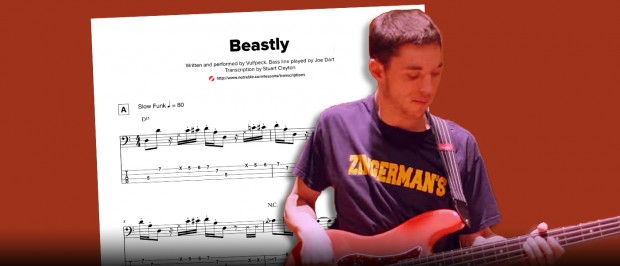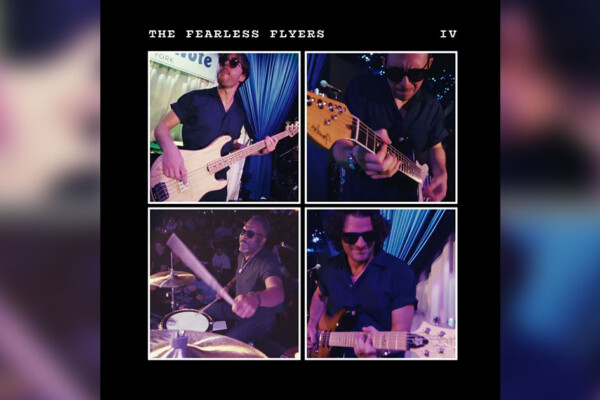Bass Transcription: Joe Dart’s Bass Line on Vulfpeck’s “Beastly”

This month’s transcription is “Beastly”, the opening track from Vulfpeck’s first EP Mit Peck. I’ve loved this piece since I first heard it and it’s been on my “transcribe list” for a while now. Fortunately, the isolated bass track cropped a while back, making the task of transcribing it a little easier.
“Beastly” is a slow funk piece built around bassist Joe Dart’s infectious bass hook (bars 1-4). When playing this line pay close attention to staccato indications and ghost notes: although the staccato notes are sixteenth notes, they should be played very “clipped” in order to achieve the same vibe that Joe has here. The ghost notes have been written on the string on which it is most logical to play them. You don’t have to stick to this of course. Note that occasionally Joe’s ghost notes become harmonics as in bars 9, 18 and 19. This is a cool effect and works since the harmonic notes work well with the overall tonality of the piece.
This piece features no less than three bass solos. The first, at letter B is groove-based, featuring plenty of octave licks. Check out Joe’s use of shakes in bars 5 and 9 – a classic funk ingredient that adds some “grease” to a lick (note: shakes are performed by rapidly moving the same finger of the fretting hand from side to side over two notes. The effect is similar to a trill, but sounds funkier).
Joe shifts up a gear for the second bass solo beginning at D. Note the use of the D blues scale for the quick-fire descending licks (bar 21) and the use of octave-based licks again. The octave phrase from bars 22-24 is tough, both in terms of technique and timing. Practice this slowly and work closely with the track as a guide when learning this part. This solo leads back to the main groove, which is followed by a new section (letter F) in which Joe plays a C minor-based unison figure with the piano. This is simple to play, but sounds great and is a nice break from the D tonality used so far.
The third solo is at letter H and begins with an ascending octave lick. The ghost notes between the octave figures should be played with the raking technique: pluck the note on the G-string, then rake backwards across the D and A-strings with the same finger. More quick-fire blues scale licks follow, leading into some repetitive phrases (40-41) that are easier to perform than they are to read. Note that the D’s in parentheses in bar 40 are almost ghost notes, but still retaining an element of pitch. This solo leads back into the main groove, which this time Joe embellishes with fills. Note the brief use of the octave pedal in bar 52. The track closes with a repeat of the unison melody from earlier in the piece.
This is a tough piece to get together. While the ultimate goal should be to improvise your own solos, I recommend learning Joe’s parts here first, so that your own solos can be informed by his approach. The solos on this track are a fantastic demonstration of how much you can do with some simple scale choices (blues scale, pentatonic etc) combined with energy and groove.
Download the transcription (standard notation and tab).
Here is the isolated bass track:
Here is the original track with the full band:
Stuart Clayton writes for and runs Bassline Publishing, a small company who specialize in bass guitar tuition and transcription books. Check out basslinepublishing.com for more.




Thank you. Awesome job.
Yikes !! Way to go,Joe Dart & band …..that has got some real NASTY on it ?? Bass On !!
Joe is a monster player.
Thanks!!! This is awesome!!!
You should create a room in your transcription schedule for this : https://www.youtube.com/watch?v=37fEqJJH9K4
Thanks so much for this. I started working on the technique yesterday.
have you transcribed any badbadnotgood
their bassist is awesome